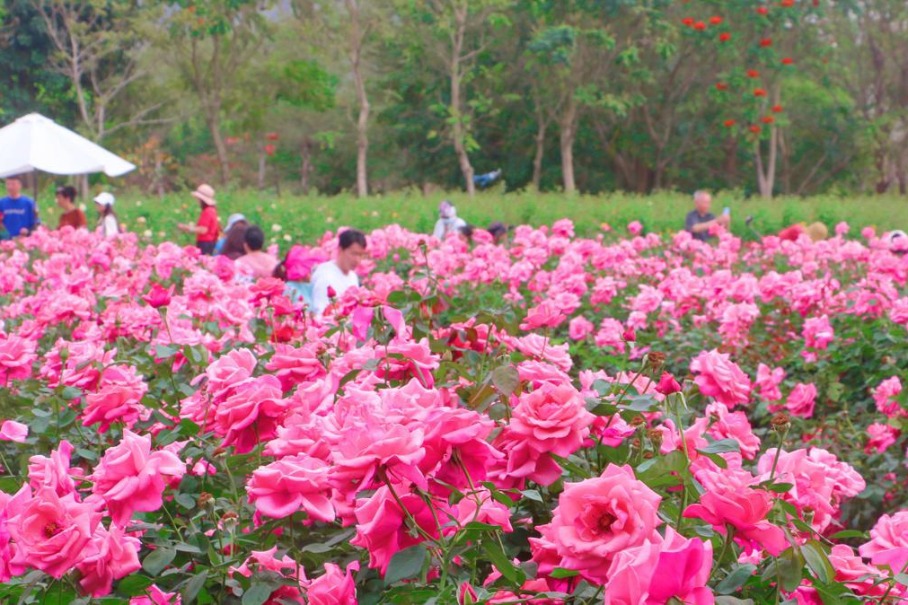A 3-day trip in Guangdong province

Transit passengers from 51 countries including the US and Canada can spend up to 72 hours in Guangdong province without a visa. This visa-free policy allow foreigners from these 51 countries with visas and plane tickets to a third country to transit through Guangdong province for a visa-free stay of up to 72 hours.
Guangdong province is located in the southernmost part of the Chinese mainland. It borders Fujian province in the east and Jiangxi and Hunan provinces in the north. To the west is Guangxi Zhuang autonomous region, and to the south is the South China Sea.
China's second largest river - the Pearl River - flows through Guangdong. To the east of the Pearl River Estuary is the Hong Kong Special Administrative Region, and to the west is the Macao Special Administrative Region. The southwestern Leizhou Island in Guangdong is separated from Hainan province by the Qiongzhou Strait.
Covering an area of 179,700 square kilometers, of which 1,448 square kilometers are islands, the province has 21 prefecture-level cities. The province's unique geography and climate serve as rich tourism resources. At the end of 2017, the province was home to 12 national 5A-level tourist attractions and 172 4A-level attractions. Well-known tourist sites, such as the Guangzhou Chimelong Holiday Resort and the Shenzhen OCT (overseas Chinese town) East Resort are now home to various international activities and events.
Transit passengers from 53 countries including the United States, Canada, and all members of the European Umion can spend up to 72 hours in Guangdong without a visa. This visa-free policy allow foreigners from these 53 countries with visas and plane tickets to a third country to stay in Guangzhou visa-free for up to 72 hours. Below is a suggested itinerary for a three-day trip in Guangzhou. It includes many scenic spots and plenty of delicious Cantonese food.
Day one: Guangzhou
The city of Guangzhou is home to rich tourism resources and you will never regret visiting. Your first stop can be Guangzhou Baiyun Mountain Scenic Area, which is renowned as the "No 1 Scenic Area in Guangzhou" and the "No 1 Mountain in South China".
Baiyun Mountain is made up of more than 30 hills and covers an area of 21.80 square kilometers. Its highest peak, Moxing Ridge, is 382 meters high. The picturesque mountain is rich in overlapping ridges, peaks and freely extending brooks, forming a natural barrier in the north of Guangzhou. Baiyun Mountain takes its name from the floating clouds atop the mountain after a late autumn rain – a spectacular sight.
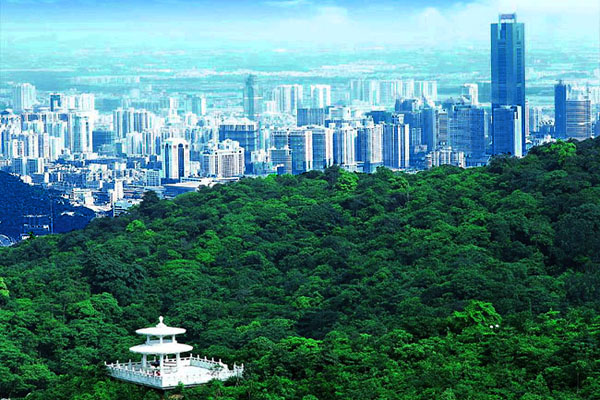
Tourists can enjoy a panoramic view of Guangzhou and the distant Pearl River from the top of the mountain. [Photo provided to govt.chinadaily.com.cn]
After enjoying the picturesque mountain views, you can head downtown and pay a visit to Yuexiu Park, which boasts over 80 years of history.
The park has numerous tourist attractions, such as the Zhenhai Tower, the Foshan Archway, the Ancient City Wall, the Sifang Emplacement, the Sun Yat-sen Monument, the Monument at the Study and Office of Sun Yat-sen, Wu Tingfang Graveyard, the Emperor and Officials' Graveyard of the Shaowu Regime of the Ming Dynasty, the Sailors' Pavilion, the Five Rams Monument, the Five Rams Legendary Sculptures, and the ball-shaped water tower.
Apart from the park's landscapes, visitors can also visit the most iconic piece of Lingnan architecture- the Ancestral Temple of the Chen Family, which was built in 1894. The temple is a compound complex consisting of nine halls, six courtyards, and 19 buildings connected by corridors. The most impressive attractions in the temple are the superb carvings extolling nature. The wood carvings, in particular, demonstrate some of the finest artwork in Guangdong.
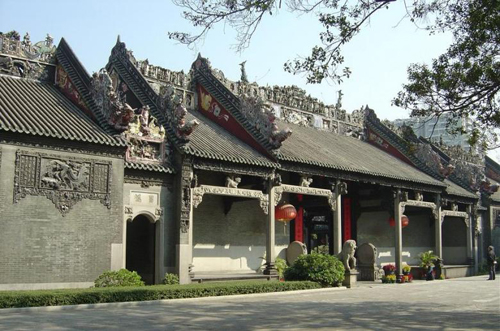
The Ancestral Temple of the Chen Family, also known as the Chen Clan Academy, is a place for both offering sacrifices to ancestors and for study. [Photo provided to govt.chinadaily.com.cn]
Your trip in Guangzhou isn't complete without a visit to Shamian Island. Shamian has served as an area of mercantile importance since the Song Dynasty (960-1279). From the Qing Dynasty (1644-1912) onwards, its importance doubled as a strategic point of defense during the second Opium War (1856-1860). In 1859, the island's territory was gobbled up by Western imperialism, as it was split into concessions for the French and the United Kingdom (four fifths of the territory went to the British, with the remaining fifth went to the French).
The territory today features architecture that befits its cosmopolitan history, with the mansions on the island being some of the best preserved Western European style buildings in the country. More than 40 buildings have been counted amongst the most exotic in Guangzhou, exhibiting traits of Gothic, Baroque and Neoclassical architecture.
Famous attractions on the island include the Catholic Church Our Lady of Lourdes, built in 1892, the British Protestant Church Christ Church of Shameen, built in 1865, and the Guangdong Foreign Affairs Museum.

Shamian Island features quiet pedestrian avenues flanked by trees and historical buildings. [Photo provided to govt.chinadaily.com.cn]
Day two: Zhuhai
The Meixi Royal Stone Archways is a great place to visit in Zhuhai. It is a key historical site under state protection. The monuments are situated at the former residence of Chen Fang (Chun Afong), a Chinese merchant and China's first consul in Hawaii. As a tourist attraction, the archways combine the commemoration of celebrities with folk custom exhibitions and cultural relics protection. The tourism zone includes the plaza of the Meixi Royal Stone Archways, the residence with family history on display, and Chen Fang's garden. The buildings combine Chinese and Western elements. There are also the Waxworks Hall of Historical Figures of Zhuhai and a Folk House exhibition.
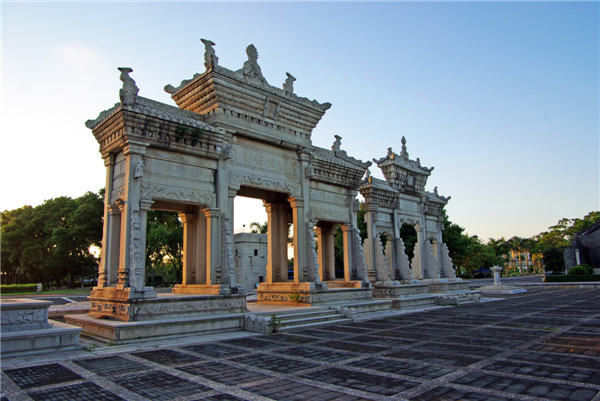
A photo of the Meixi Royal Stone Archways. [Photo provided to chinadaily.com.cn]
Another great tourism attraction you don't want to miss in Zhuhai is the Fisher Maiden statue, which is considered the symbol of Zhuhai. Voluptuously outstretched above the waves curving into Xianglu Bay in the eastern downtown section of Xiangzhou, she extends a glistening silver pearl toward the heavens, manifesting enlightenment for people here and beyond the seas. This enrapturing monument of love is the masterpiece of Pan He, China's renowned sculptor. Created in 1982, it is carved from 10 tons of granite in 70 pieces stacked to a height of 8.7 meters.
In the afternoon, you can tour the New Yuanming Palace (Zhuhai Cultural Park), which is composed of 18 sites simulating those of the Old Summer Palace (Yuanming Yuan) in Beijing on a 1:1 scale and costing 600 million yuan. It is open to the public free of charge. Occupying 600,000 square meters, the building complexes comprise royal palaces, gardens in the Jiangnan (the region south of the Yangtze River) style, and European structures. There are over 40 scenic spots, including Fuhai Lake at the center. A panoramic epic show, Reminiscing of the Old Summer Palace, is performed at the central theater in the evening, requiring an admission ticket.
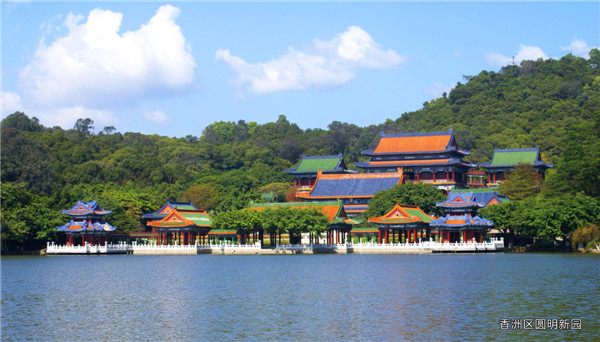
A photo of New Yuanming Palace in Zhuhai. [Photo provided to chinadaily.com.cn]
Day three:
During the third day of your trip, take a trip to Shenzhen, which has been on the frontlines of China's reform and opening-up. In the morning, spend an hour and a half shopping on Chung Ying Street on the border between Hong Kong and Shenzhen.
After shopping, spend an hour at Meridian View Center, an iconic building in Shenzhen and the first skyscraper-themed scenic spot in Asia. Numerous Chinese and foreign heads of state, political figures, and people from all walks of life have unanimously given the spot a thumbs-up. In the afternoon, take a bullet train to Guangzhou and continue your trip.
Food tips:
As one of the Eight Culinary Traditions of Chinese Cuisine, Cantonese Cuisine is characterized by its great diversity of ingredients, elaborate preparation methods, and strong emphasis on texture, aroma and taste.
A day in Guangzhou begins with morning tea, one of the highlights of traditional Cantonese culture. The iconic five-star city resort in the historic heart of Guangzhou, the White Swan Hotel offers the best morning tea and Cantonese food in Guangdong. The most delicious item on the menu is shrimp dumplings, which is a must-order morning tea snack for most overseas returnees.
A shrimp dumpling should have 12 pleats and steam for just five minutes to make the skin semi-transparent. The stuffing is made with whole shrimp and served with a small amount of fat pork, and adding just the right amount of pepper can make it taste even better.
If you want to try the most authentic Cantonese dim sums, go to the Guangzhou Restaurant, located on No 2 Wenchang Road, Liwan district, Guangzhou.
Known as the "Top Restaurant in Guangzhou", the restaurant represents the finest Cantonese cuisine, and has also inherited the traditional Cantonese-style teahouse culture with first-class morning tea. The best Cantonese food here includes Bamboo Shoots and Crystal Shrimp Dumplings and Supreme Abalone Sauce Cha Siu Baa.
Quxi Restaurant is a well-known old-fashioned garden-themed restaurant in Guangzhou. It is next to the beautiful Liwan Lake Park and was designed by famous Chinese architect Mo Bozhi. The restaurant combines the characteristics of Lingnan Garden with the essence of its decorative art: the restaurant is adorned with a rockery fish pond, curved gallery, lake heart peninsula restaurant, and boat-like buildings providing seafood. Famous foods include rabbit-shaped shrimp dumplings, ginger-flavored chicken feet, and water chestnut cake.



